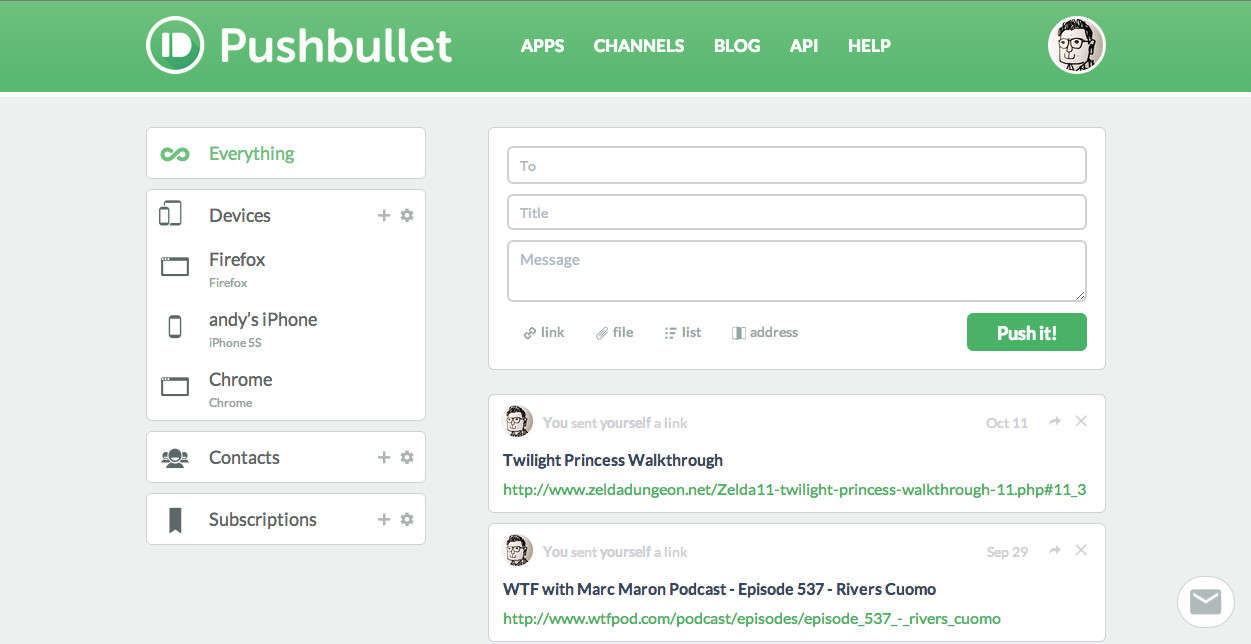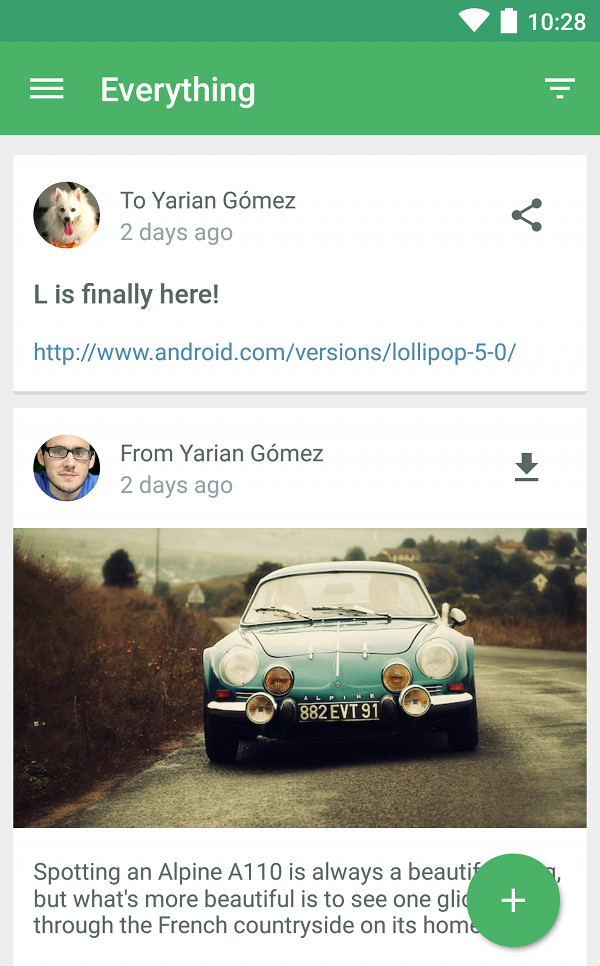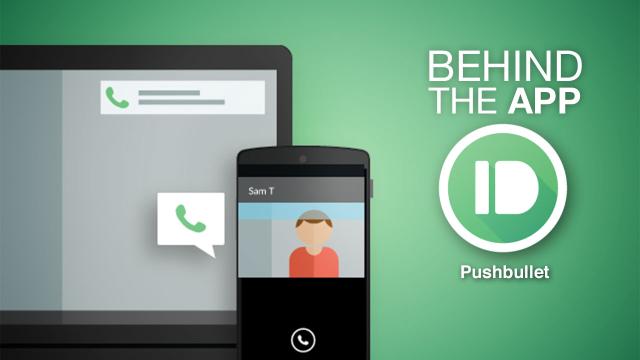We all live across multiple screens as our gaze hops from our phones to our laptops and to our tablets. How do you keep yourself in order when your digital life is sprawled about like a messy office? Pushbullet is working towards an answer.
In its simplest form Pushbullet acts as a relay between your desktop and phone, so you can receive text messages and other notifications on your desktop — or push or data to your phone. Of course, this sort of functionality is baked in to some newer operating systems, but Pushbullet is aiming to bridge any device and OS.
It began as a side project from Ryan Oldenburg in 2012, and launched the following year to a welcome reception from Android users who were looking for better ways to relay information between devices. We caught up with Ryan to learn more about why the project started and what he has in mind for its future.
Where did the idea for the app come from? Were you trying to solve a problem you’d experienced, or did the inspiration come from somewhere else?
Ryan Oldenburg: I got started on Pushbullet because of the pain I felt trying to send stuff between my phone and computer. I’d literally end up emailing myself links and files just to get them from one to the other. I know almost everyone still doe too, which is funny in a depressing kind of way. Pushbullet started as an easier and faster way to move links and files between devices.
The way Pushbullet could actually achieve this hit me when Jelly Bean (Android 4.1) came out. Jelly Bean added support for rich notifications, which let you see content within a notification, and even have buttons. When I saw that this let me read my email (and even archive them) without opening the Gmail app, it became obvious to me that the notification tray was now the most useful part of my phone.
Near the same time, I’d tried Google’s Chrome to Phone extension and thought it was really cool. The extension lets you instantly send a webpage into the notification tray on your phone. Google abandoned the project as just a tech demo, but I knew there was a huge amount of potential to the concept of instant transfers combined with a notification for super easy access.
After making link and file transfers between devices dead simple, I realised that the system for sharing information between devices that we’d built had a ton of other potential uses. The first feature we added next enabled people to see and dismiss notifications from their phone while on their computer.
Being able to see and dismiss my phone’s notifications on my computer came 100 per cent out of personal desire. Not having to grab my phone all the time while working at my computer is both incredibly convenient and also essentially “how things should work.” The fact that I got an email isn’t meant for just my phone — it’s meant for me. I should see this notification on all of my digital devices and should only need to dismiss it once, too. This seems obvious, but before we built it, this didn’t exist.

After you came up with the idea, what was the next step?
Getting started building.
I started working on Pushbullet as a side project while working full time at Hipmunk. First I decided on the functionality I’d need to have in the first version to prove that I wasn’t the only one that would want this app (I started with simple link transfers), and then I got to work over the holidays building the Android app, website, and backend.
How did you choose which platforms to target and which to ignore or wait on?
I started on Android because I’d been an Android developer for a few years, which made this choice an easy one.
What was your biggest roadblock and how did you overcome it?
My biggest roadblock was probably just getting all of the pieces working together and into a shippable state. This was difficult since, as I said, Pushbullet started as a side project. It’s not easy to work full time and then spend all of your free time on a side project. I think a countdown starts when you begin a side project: you need to get your first release out in time or you’ll run out of steam.
For me, while I was confident on Android, I hadn’t built a backend nor a website in years. And when I had, it was on top of an existing system. Getting everything working from nothing, including the front-end design, the database, servers, the authentication system, the sign-up email — even deciding the app name and colours — it all adds up fast and can get overwhelming for one person.
What was launch like for you?

Pushbullet’s launch was actually quite successful. I think we got lucky in that, but I’m certainly not complaining.
I released Pushbullet on a Sunday so I’d be off of work and able to focus on whatever happened.
Launching consisted of just submitting the launch blog post to Reddit’s Android community and to Hacker News. Both of the submissions are linked to at the bottom of the post.
While Hacker News was somewhat receptive, Reddit’s Android community reacted extremely enthusiastically, which was awesome. Based on their feedback, I rushed out a Chrome extension to Pushbullet the next week.
From there, Pushbullet hit 15,000 users in just those two weeks. You can imagine how excited I was, and we’ve basically been at it since.
How do you handle user requests and criticisms effectively?
Handling user requests and criticism well for us is largely about seeing the feedback and being seen responding to it. We get a lot of our feedback in public, so we respond in public as well.
This includes the Android subreddit and our own subreddit, our Google+ page and beta community, as well as the comments on our blog posts and any posts written by the media about us.
We read all of these posts and the comments on them, and try to reply to a large amount of them every time. As a result, we’ve earned a reputation for being responsive and accessible. This reputation has earned us a lot of good will and made people more willing to give us feedback. This is a great benefit considering how critical great feedback is to continuing to grow.
Now, how do you split time between developing new features and managing existing ones?
I believe there are few things more annoying than software that isn’t reliable. This means we focus on squishing bugs as soon as we hear about them.
It does take time, but by staying on top of them so the bug list never gets out of control, it really doesn’t take that much time. It’s also how Pushbullet has earned it’s status as one of the best reviewed and most reliable apps out there.
Developing new features is what we spend most of our time working on. New features, however, isn’t quite how I’d describe it. I consider most of what we work on to be “missing features” — meaning things that we should obviously add but just haven’t been able to build yet.
Our focus on filling the gaps in our functionality instead of “new tricks” means we’ve avoided losing focus and our app just “getting bigger.” Instead, Pushbullet is always actually getting better.
I’ve noticed you tend to release new features as you develop them, rather than doing sporadic but larger revisions to the app. Are fast iterations something you prioritise?
Iterating on ideas and getting things out fast is a sort of classic piece of advice given these days. I believe it is definitely correct as well. Though many people believe the reason to do so lies in being able to quickly respond to feedback and improve the product, I’d say the reasoning for us is a bit more complex:
First, it feels good to have a real momentum behind you. It keeps us pushing forward and keeps our users excited to hear about the next update too, because they know it’s coming.
It also means we avoid having those really scary launches where everything has changed and you just sort of pray it goes alright. These can be seriously demotivating.
Not getting locked into a giant release also means we can respond to feedback or fix bugs fast. Not “fast” as in weeks or months — I mean fast as in hours or days, depending on what we’re talking about.
When it comes down to it, our experience as developers has taught us that releasing often is simply better for our motivation and energy. When things slow down, basically everything gets worse.
What do you picture Pushbullet being like a few years from now?
Everyone is only going to have more devices in their lives over the next few years. Phones, tablets, and computers continue to become more ubiquitous. This means Pushbullet’s opportunity to save people time and enable unique and convenient functionality only gets more exciting going forward.
What advice would you give to others that want to take on a similar project?
Pushbullet has grown into a quite large piece of software that, in many ways, seems deceptively simple. If I’d started working on it with both the ambition to build what it is today and the stubbornness to require that all our current features were included very first version, however, Pushbullet wouldn’t exist. So many great ideas never make it out into the world because the person working on it doesn’t get the project to a release before stopping.
If you’re really excited about a project, the best way to make it to the finish line is to keep it simple at first. There is always some single element you can distil your app or service down to. Get that most basic value-add released and feel what the real world thinks of it as soon as you can. It’s great to grow from there.
Lifehacker’s Behind the App series gives an inside look at how some of our favourite apps came to be — from idea to launch (and beyond).

Comments